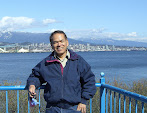
Dear Sugeng,
I wrote you last February 25,2007 about Nanaimo. Well this is kind of the sequel. I went there again last May 1,2007 for 2 weeks to visit Tan's family and their restaurant in North Nanaimo. This time I boarded the "Queen of Cowichan" from Horseshoe Bay ferry terminal. It is a large ferry that can carry 360 cars and 1500 passengers.
There was a lot of activities going on at the Horseshoe Bay ferry terminal. It was due primarily by the transportation requirements for the 2010 Winter Olympics in Whistler.

There was road expansion of the sea to sky highway at the Horseshoe Bay, better access for cars & passengers to the ferry terminal, and the expansion to the terminal "A" pier for the new Super-C class ferry that is forthcoming.
The road expansion to Whistler at Horseshoe Bay would be the building of overhead pass to by pass the congestion from ferry line up that on long weekends sometimes could stretched up to 3 km long on the Trans Canada #1. For that purpose they needed to cut the hills and trees on the hills. But some people did not take kindly on that idea, resulting in the sit in protest by local residents and

environmentalist groups. There were also complaints about the noises and dusts generated from the constructions. But after some considerations and assurances from authorities, the constructions started again full steam ahead.
Cars access to the ferry terminal was also needed upgrading, because the bottlenecks that were created by the long line up prevented smooth flows of traffics to go to Squamish and Whistler. Toll booths and the waiting rooms for cars going to the ferry needed to be expanded too. With 2 scheduled ferry delays for example, and it is not uncommon, about 2000 cars would be waiting on the line up. That is a lot of cars. So they are creating up to 24 lanes over 1 km distance space for cars lining up for the ferry. It would be a huge parking lot for sure. And the construction on the hilly rocky granite of Horseshoe Bay also posed some challenges. So far they were making progress.
There are 3 terminals at Horseshoe Bay, they call them terminals A,B and C. The A was needed to be upgraded, to be made stronger and wider. Work was underway at terminal A and at Departure Bay terminal, to prepare for the berths of the new Super-C class that are currently under construction in West Germany. There was a controversy that the tender for the ferry construction was not awarded to B.C. company. But because the local company was quoting much higher price, and the previous experience of "way over budget and way not on time delivery", the construction was given to foreign company. So far the news on the new ferry is "on time and on budget". The first ferry would be called "Coastal Renaissance" and expected the operation start in November 2007 for the Horseshoe Bay - Departure Bay route. The 2 other ferries, "Coastal Inspiration" and "Coastal Celebration" would come in stages for the next 2 years. They would be used for the Tsawwassen - Swartz Bay route. Evidently the Super-C class ferry is 160 metres long, can carry 370 cars and 1650 passengers with a speed of 21 knots.
Top photo shows the activities at terminal A, where piles were being readied to be driven deep down to the ocean floors, reportedly up to 22 piles. A project of 2 1/2 years and would be summer 2007 completion.
I was helping the Tan's in the restaurant again this time mostly as waiter. But something unusual happened. The Canucks hockey team making the play off. Good news for hockey fans but bad news for Tan's restaurant. Because every time Canucks shown on TV, few customers coming in for dinner, most customers prefer to stay home and watch hockey on the tube instead. The Tan's quietly wished that the Canucks would loose and out of the play off. But lunch time was always busy anyway to offset for the slow evenings.
When I stopped at Chemainus to check at the murals again, I stopped at the Waterwheel Park at town centre and saw this red bark tree shown on bottom photo. It was the Arbutus tree. The Arbutus trees are natives to B.C., evergreen trees that can grow up to 25 metres tall. Apparently the Native people using the bark and the leaves for medicinal purposes. That reminded me of my grandparents in Seribudolok, Sumatra. That they were very good at using some bark and leaves for medicinal purposes to cure many ills. Arbutus trees bear fruits with lot of seeds. Birds and other animals like to eat the fruits and spread the seeds everywhere at the same time. Arbutus trees are very hardy and can grow in any location where the seeds happened to drop, even on the rocks, hills near the beach, on the windswept areas. Because the roots are very invasive, deep and strong, can grow even if the soil is minimal. I was beginning to notice that Arbutus trees were growing every where in and around Nanaimo. With the distinct red or brown bark, they looked strong and beautiful trees, especially the ones that grow on the rocky hilly windswept areas.
(Top photo): Terminal "A" construction at Horseshoe Bay.
(Middle): On top deck of the "Queen of Cowichan".
(Bottom): Arbutus tree at Waterwheel Park, Chemainus.
 Dear Harry Hutapea,
Dear Harry Hutapea, Middle photo was taken from the same spot 2 1/2 months later in May 25,2007. The trees were full of leaves and blooms.
Middle photo was taken from the same spot 2 1/2 months later in May 25,2007. The trees were full of leaves and blooms.







